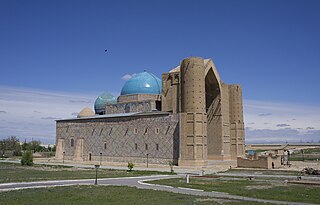| Mausoleum of Khoja Ahmed Yasawi | |
|---|---|
 View of the Mausoleum of Khoja Ahmed Yesevi in Turkestan, Kazakhstan. | |
| General information | |
| Type | Mausoleum |
| Architectural style | Timurid |
| Location | Turkistan, Kazakhstan |
| Coordinates | 43°17′52″N 68°16′15″E / 43.29778°N 68.27083°E |
| Construction started | 14th century |
| Official name | Mausoleum of Khawaja Ahmed Yasawi |
| Type | Cultural |
| Criteria | i, iii, iv |
| Designated | 2003 (27th session) |
| Reference no. | 1103 |
| Region | Asia-Pacific |
The Mausoleum of Khawaja Ahmed Yasawi (Kazakh: Қожа Ахмет Яссауи кесенесі, romanized: Qoja Ahmet İassaui kesenesı) is a mausoleum in the city of Turkestan, in southern Kazakhstan. The structure was commissioned in 1389 by Timur, who ruled the area as part of the expansive Timurid Empire,[1] to replace a smaller 12th-century mausoleum of the famous Turkic poet and Sufi mystic,[2] Khoja Ahmed Yasawi (1093–1166). However, construction was halted with the death of Timur in 1405.[3]
Despite its incomplete state, the mausoleum has survived as one of the best-preserved of all Timurid constructions. Its creation marked the beginning of the Timurid architectural style.[4] The experimental spatial arrangements, innovative architectural solutions for vault and dome constructions, and ornamentations using glazed tiles made the structure the prototype for this distinctive art, which spread across the empire and beyond.[3]
The religious structure continues to draw pilgrims from across Central Asia and has come to epitomize the Kazakh national identity.[3][5][6] It has been protected as a national monument, while UNESCO recognized it as the country's first site of patrimony, declaring it a World Heritage Site in 2003.[7]

- ^ Cite error: The named reference
timuridwas invoked but never defined (see the help page). - ^ Ro'i, Yaacov (2000). Islam in the Soviet Union: From the Second World War to Perestroika. New York: Columbia University Press. p. 373. ISBN 0-231-11954-2.
- ^ a b c Cite error: The named reference
whswas invoked but never defined (see the help page). - ^ Cite error: The named reference
brittanica2was invoked but never defined (see the help page). - ^ Cite error: The named reference
hazratwas invoked but never defined (see the help page). - ^ Cite error: The named reference
geopoliticalwas invoked but never defined (see the help page). - ^ Cite error: The named reference
inscribewas invoked but never defined (see the help page).
